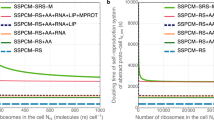Abstract
IT is well known that chicken fibroblasts invariably die after a certain number of doublings in vitro (cell senescence) and that they have never been established by any chemical or physical agent1. On the other hand, mouse fibroblasts invariably acquire spontaneously an infinite growth potential, and transformation can be induced at a high frequency by different oncogenes2. Other species like man also yield fibroblasts which never acquire spontaneously the capacity to divide for ever3 but can become permanent cell lines after infection with SV40 virus4. Transformation in human fibroblasts has only been unequivocally demonstrated after treatment with certain viruses. This behaviour of fibroblasts in vitro has been attributed to different nutritional requirements5. The two approaches to explain the phenomenon can be summarised as intrinsic properties against environmental conditions. We have previously shortened the life-spans of cultivated chicken fibroblasts with low dose rate ionising radiation6. We have carried out the same type of experiment with human and mouse fibroblasts and found that the response to ionising radiation fits the relative tendencies of these different fibroblasts to yield permanent cell lines.
This is a preview of subscription content, access via your institution
Access options
Subscribe to this journal
Receive 51 print issues and online access
$199.00 per year
only $3.90 per issue
Buy this article
- Purchase on Springer Link
- Instant access to full article PDF
Prices may be subject to local taxes which are calculated during checkout
Similar content being viewed by others
References
Pontén, J., Virol. Monogr., no. 8, 25 (Springer, New York, 1971).
Earle, W. R., J. natn. Cancer Inst., 4, 165–212 (1943).
Hayflick, L., and Moorhead, P. S., Expl Cell Res., 25, 585–621 (1961).
Girardi, A. J., Jensen, F. C., and Koprowski, H., J. cell. comp. Physiol., 65, 69–78 (1965).
Moore, G. E., and McLimans, W. F., J. theor. Biol., 20, 217–226 (1968).
Lima, L., Malaise, E., and Macieira-Coelho, A., Expl Cell Res., 73, 345–350 (1972).
Todaro, G. J., and Green, H., J. Cell Biol., 17, 299–313 (1963).
Terzaghi, M., and Little, J. B., Nature, 253, 548–549 (1975).
Dean, C. J., Feldschreiber, P., and Lett, J. T., Nature, 209, 49–52 (1966).
Author information
Authors and Affiliations
Rights and permissions
About this article
Cite this article
MACIEIRA-COELHO, A., DIATLOFF, C. & MALAISE, E. Doubling potential of fibroblasts from different species after ionising radiation. Nature 261, 586–588 (1976). https://doi.org/10.1038/261586a0
Received:
Accepted:
Published:
Issue Date:
DOI: https://doi.org/10.1038/261586a0
Comments
By submitting a comment you agree to abide by our Terms and Community Guidelines. If you find something abusive or that does not comply with our terms or guidelines please flag it as inappropriate.



